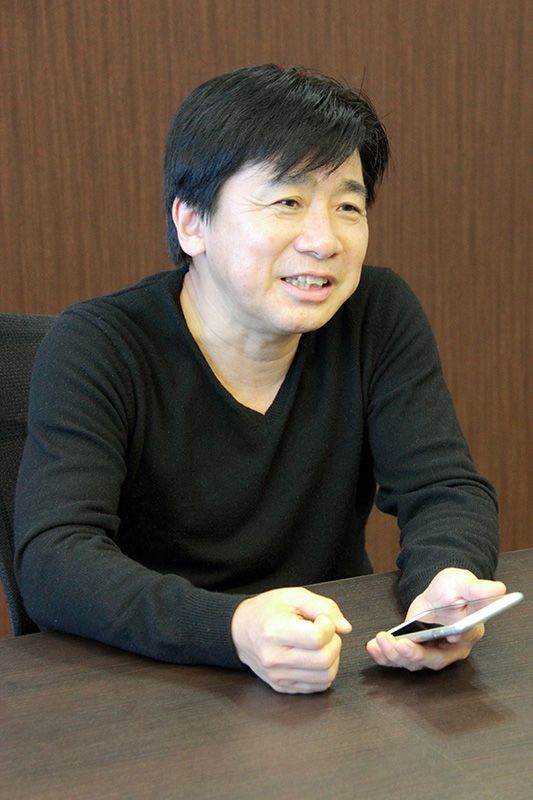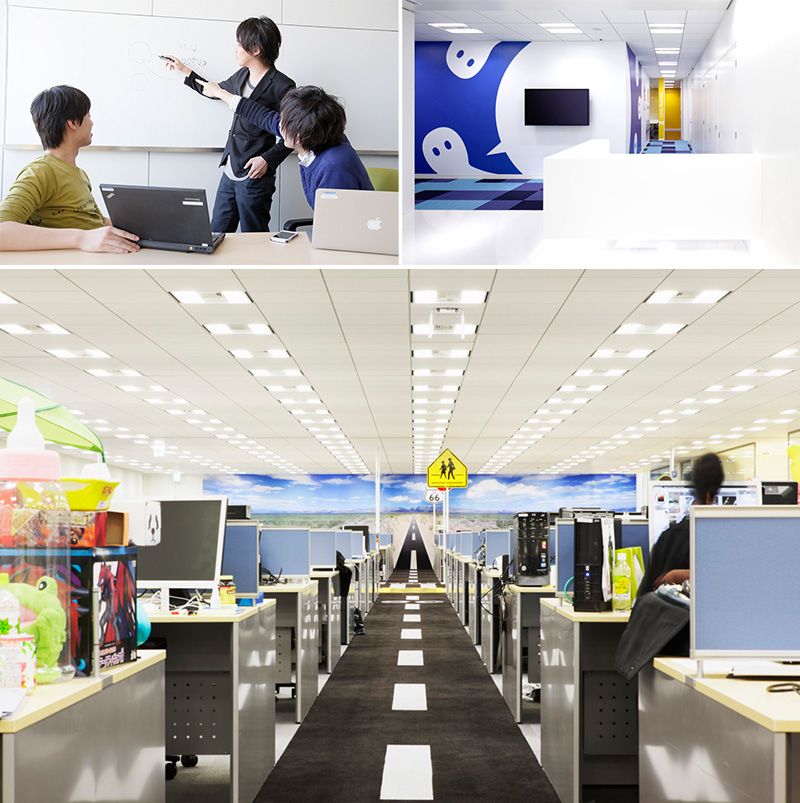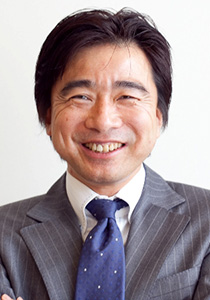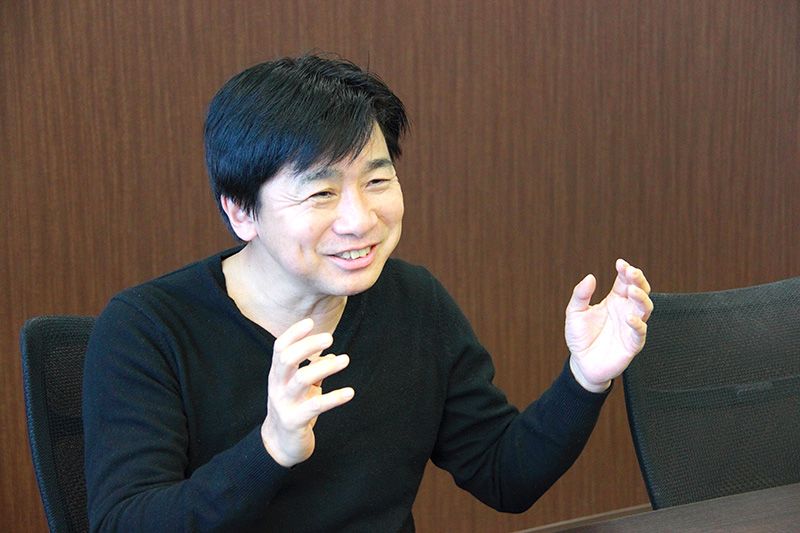
Japan’s Game Industry Jumps to New Platforms
Many Ways to Play: A Mobile Game Creator Looks at Global Trends
Economy Society Culture- English
- 日本語
- 简体字
- 繁體字
- Français
- Español
- العربية
- Русский
Console Games Still Popular Outside Japan
INTERVIEWER There seems to be a tectonic shift underway in game platforms. Now that mobile games have become the main format, companies that had dominated the console game market, like Nintendo and Sony, are in decline.
SANADA TETSUYA It’s certainly true that Japan’s console vendors like Nintendo are not doing well. But that’s only the situation in Japan. If you look at the global market, it becomes clear that PlayStation 4 surpassed the 20 million unit sales milestone at record speed, and it has been selling even better in Europe and North America than PlayStation 3 did.
For the past few years, the console game market in Japan has been shrinking, in terms of both hardware and software. It’s now around the 400 billion yen level. In contrast, the console market in Europe and North America has been expanding, so there is a huge gap between those two situations.
But turning to Asia, the situation is again different. China and South Korea did not have console games to begin with. Plus, exports of games to China were once not possible due to the problem of piracy and restrictions placed on exports to Communist bloc countries under the Coordinating Committee for Multilateral Export Controls. Since they didn’t have consoles, the gaming culture in those two countries revolved around games played on PCs, either at home or at the PC bang LAN gaming centers. Chinese and Koreans developed their own original online gaming cultures and games that were unique to their own countries.
INTERVIEWER How do you account for the fact that the console market in Japan has declined, while mobile phones have become the main gaming format?
 SANADA In discussing the relationship between console and smartphone gaming, people in Europe or North America often draw comparisons to the dynamic between movies and television. That is to say, when television first arrived on the scene, there was a view that film culture would wither away. But what happened, in fact, was that the film industry started to produce more and more big-budget films to set itself apart from TV shows. By spending millions of dollars on such films, the industry succeeded in carving out its own niche.
SANADA In discussing the relationship between console and smartphone gaming, people in Europe or North America often draw comparisons to the dynamic between movies and television. That is to say, when television first arrived on the scene, there was a view that film culture would wither away. But what happened, in fact, was that the film industry started to produce more and more big-budget films to set itself apart from TV shows. By spending millions of dollars on such films, the industry succeeded in carving out its own niche.
This same logic can be applied to the console market. In Europe and North America, console games from studios like Take-Two Interactive and Ubisoft offer incredibly high-resolution graphics that almost rival the quality of a film. These are high-budget games that cost as much as 30 billion yen to produce. There’s no way to recreate that visual impact on a tiny smartphone screen.
The gap today between the budgets on console game production in Japan and in the United States is as wide as the gap between Hollywood movies and Japanese films.
We’ve reached the point today where the best-selling 3D smartphone games have budgets of around 200 or 300 million yen, which is more than the production costs of some Japanese films. Apart from some super-big-budget console titles, like the Final Fantasy series, about as much is spent in Japan on developing games for smartphones as for consoles.
In short, we can see in Europe and North America that there is a trend toward console games with highly realistic graphics, such as first-person shooters. Meanwhile, in Japan, it seems that one reason console games have lost out to smartphone games is that the console makers have not been able to establish a niche in the way that the movie industry once did in the face of the rise of television.
In this way, the game market in Japan began to fall into the so-called Galapagos syndrome, developing in a way that led to its isolation from global market trends. My own theory is that this development can be traced back to around the time of the first Dragon Quest game. Influenced by the popularity of that title, Japan headed in the direction of 2D role-playing games, whereas Europe and North American moved toward high-impact 3D games. And smartphones are well suited to role-playing games, since it’s possible to battle with or against a friend via those devices. This seems to me to be the reason that smartphones became the more popular gaming format in Japan.
 The Tokyo head office of KLab, whose hit smartphone apps include LoveLive! School Idol Festival and Celestial Craft Fleet. In 2015, the company is set to unveil Glee Forever! and Bleach Brave Souls.
The Tokyo head office of KLab, whose hit smartphone apps include LoveLive! School Idol Festival and Celestial Craft Fleet. In 2015, the company is set to unveil Glee Forever! and Bleach Brave Souls.
How Long Will Google and Apple Reign?
INTERVIEWER Even though there has been a shift toward mobile phones for Japan’s game industry, social network companies like DeNA and GREE, which got their start by providing mobile Internet services via NTT Docomo’s i-mode, have seen their grip weaken on platforms in Japan. Now Google and Apple are the dominant platforms globally. What do you make of this situation?
SANADA From the perspective of game vendors like me, it’s preferable to have multiple platforms in competition with each other. At the same time, you’ve got to have a stable market framework, rather than some sort of chaotic situation, to prevent confusion among users and make it easier for marketers to know what games will sell for certain platforms. There are low-quality imitation websites and content out there, so for novice users with little experience of surfing the Internet it can be hard to know which ones to choose. It would be better to have a certification system in place to indicate content that’s of high quality and can be used with peace of mind.
If a single company dominates the market so that there is no counterbalance, that company can dictate all of the conditions when it comes to royalties and other factors. Ideally, if there were three companies, for example, each would have around a 30% market share. Having three main companies to deal with would make life a lot easier for vendors.
INTERVIEWER What are the prospects for the rise of a third major player to join Google and Apple, allowing game vendors to shift their focus among the three platforms flexibly?
SANADA The history up to now has been a back and forth between horizontally integrated platforms and vertically integrated ones, where one wins out but then is surpassed by the other in turn.
More specifically, during the so-called “Wintel” era, every maker relied on Windows software powered by an Intel or other compatible CPU. This was a world where makers were integrated horizontally via those two mainstays.
What brought that era to an end was the rise of vertically integrated Apple. Apple took the approach of being integrated vertically from the bottom all the way to the top, with Apple computers using the company’s hardware and running on its proprietary operating systems, and software being sold through the Apple Store.
So the only thing that is going to end the era of Apple’s vertical integration is another wave of horizontal integration. Personally, I see great possibilities for the HTML5 market, which will be a universal platform for running everything, whether the devices are on iOS or Android. The rise of the HTML5 market could topple the era of vertical integration. Soon I think we will be seeing HTML5 games rising to prominence.
INTERVIEWER Does this mean that the third major platform could come from an Internet company with a system that enables fees to be collected for HTML5 titles?
SANADA The two key features of any successful platform are the ability to charge fees for content and the capacity to attract new users. Another strong point is its attractiveness to content creators. There are not many companies out there with a system in place to offer all three of those features; in Japan, probably only Rakuten, Yahoo, and Line. If those three companies start to make HTML5 content accessible to their users, the current situation is likely to change. In the United States, the main players would be Facebook, Amazon, and PayPal.
Chinese Gaming’s Unique Aspects
INTERVIEWER Turning to Asia, it seems that the Chinese market has been the focus of a lot of attention lately. What are the possibilities for the emergence of superstar game creators in China of the caliber of Horii Yūji [Dragon Quest] or Miyamoto Shigeru [Super Mario Brothers], who might be able to make careers for themselves in Japan or at the global level?
SANADA Only a true creative genius can come up with the sort of epoch-making games that rewrite the whole rulebook. But it seems to me that game development is heavily influenced by the experiences game creators had as children. The games that they loved as kids have an influence on the games they create as adults. It’s sort of like how the food you ate as a kid can change your physical constitution. We can clearly see that the sort of “cuisine” that smartphone gamers are consuming in Europe and North America, China, and Japan differs widely.
In the case of Japan, a lot of people played Final Fantasy or Dragon Quest as kids. The sort of games that sell well in Japan and are mass produced have been an amalgam of role playing and action, whereas in Europe and North America the market leaders have been first-person shooters, even when it comes to smartphone or casino-related titles. So you can see that the creators themselves want to play to the sort of games they grew up on.
The game creators in China today, meanwhile, grew up playing online games and had no experience playing console games; they also did not play the sort of Western video games that were available in Japan. So they’re creating kinds of content that are quite unfamiliar to Japanese gamers. This is one reason why it’s hard for game creators who have specialized in that Chinese market to make a career for themselves in the Japanese industry.
The Chinese market, incidentally, is probably going to end up becoming larger than the European and North American markets combined, so you need to have a strategy for that market. But since it’s necessary to tweak the rules of games a bit for Chinese players, at KLab we hope to thrive in that market by making adjustments for their needs at the planning stage.
Japan’s “Well-Balanced” Industry
INTERVIEWER What are your thoughts on the talent pool for the Japanese game industry?
SANADA Traditionally, Japan has tended to rely on individual superstar creators for game production. But with the development of smartphone games, it has become necessary to improve management so that a project team can pursue a common goal in a well-coordinated manner. And this, of course, also requires extensive technical knowledge to support the formation of such teams.
Game producers in Japan tend to have experience with online games as well as role-playing and action games on consoles, and sometimes they even play games from Europe and North America. I think it gives Japan an edge in game development to have many producers with this sort of “well-balanced diet.”
(Based on a March 5, 2015, interview conducted by Rick Masuzawa, a member of the Nippon.com Editorial Committee.)
Mobile smartphone Nintendo Sony PlayStation Apple Google Yahoo game KLab Final Fantasy console Dragon Quest

